2017 Porsche 911 Carrera 4 GTS Manual
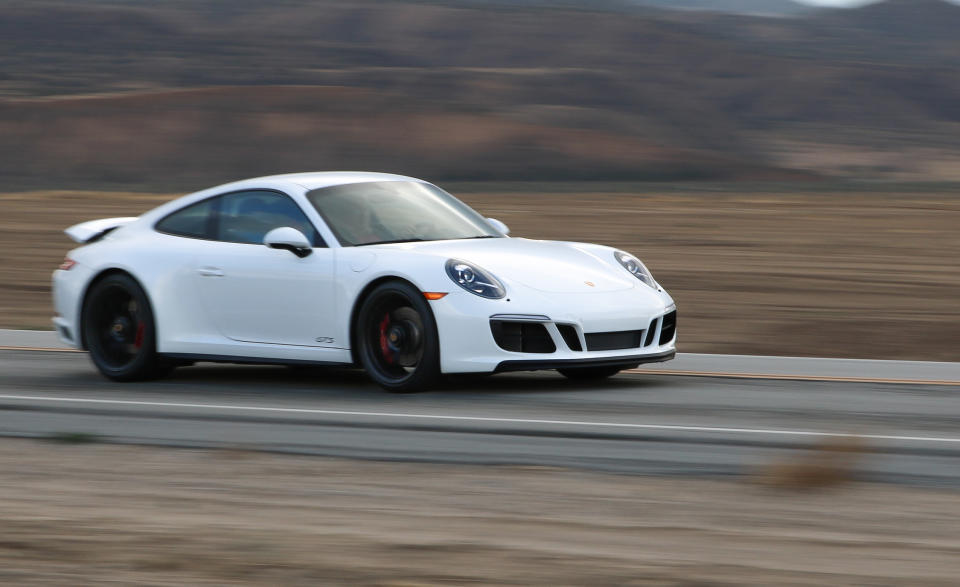
It's mind-boggling. Go to Porsche’s website and you’ll find 23 variations of the 2018 911 series listed, ranging from the $92,150 Carrera to the $294,250 GT2 RS. And each can be loaded up from a thick options catalog including custom paint colors ($6960 on the base Carrera and $12,830 with the GT2 RS) and leather-wrapped air vents for $1720. Hey, if you want that little triangle at the bottom leading edge of each door window finished in carbon fiber, that’s available for $730. And yet, if it wasn’t for our self-imposed $80,000 price cap and the occasional fit of common sense, C/D’s 10Best Cars list might feature nine versions of the 911 plus the Honda Accord.
Of all the 911s, this is one, too. It’s the 911 Carrera 4 GTS coupe with all-wheel drive and a seven-speed manual transmission. The GTS is neither a rabid track-attack dog like the GT3 nor a ground-bound Millennium Falcon like the GT2. It’s more muscular than both the base 911 Carrera and the fortified 911 Carrera S, but its robust torque production is even more forgiving in everyday use. The ride is comfortable, the tires are wide, the brakes phenomenal, and the car turns into corners with startling immediacy. This is the 911 you buy the moment you can afford the as-tested $142,945 buy in for this 2017 example, then you drive it every day until you die and you’re buried in it.
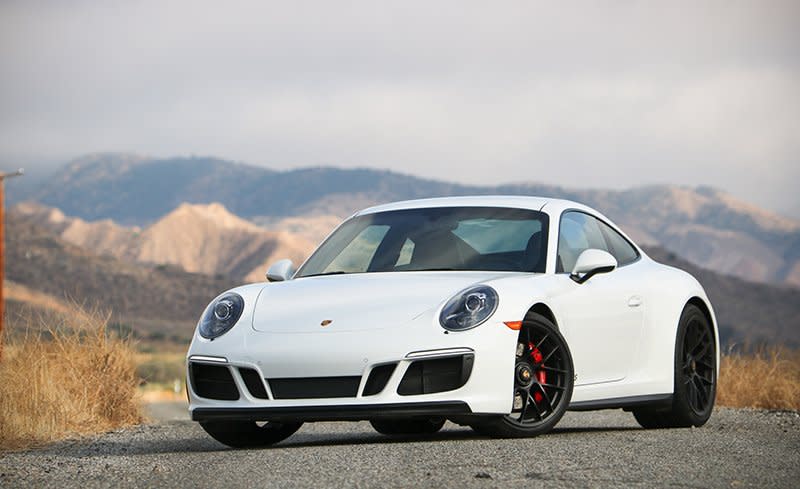
Porsche could have called this one the 911K for Keeper.
The GuTS of a GTS
Plenty of decoration surrounds the GTS package, and we’ll get to that later. The heart of the 911 Carrera GTS’s brilliance—whether it’s an all-wheel-drive “4” like this one or a rear-drive version—is the engine. Mechanical description is a disservice to this 3.0-liter passion pump. It swells and throbs as if ventricles were contracting and heaving oxygenated blood up through the 911’s aorta into the blood vessels throughout the car’s muscles. It’s not the sort of power that flattens eyeballs, but instead it’s a contraction that squeezes down and then releases as thrust. This is what it must feel like to be Usain Bolt’s thighs.
At 450 horsepower, this is the highest-output version of the twin-turbocharged 3.0-liter flat-six that powers the “regular” 911s, meaning those that aren’t capital-T Turbos or the naturally aspirated GT3. Compared with the 370-hp base Carrera and the 420-horse Carrera S, the GTS uses turbos with a three-millimeter-larger diameter turbine and a four-millimeter-larger compressor wheel in a suitably larger housing. Boost pressure thumps up from the Carrera S’s 16 psi to 18 psi to deliver a consistent 405 lb-ft of torque from 2150 to 5000 rpm. And it doesn’t fall off all that noticeably past five grand, either; it pulls with utter adamancy all the way to the tachometer’s 7400-rpm redline.
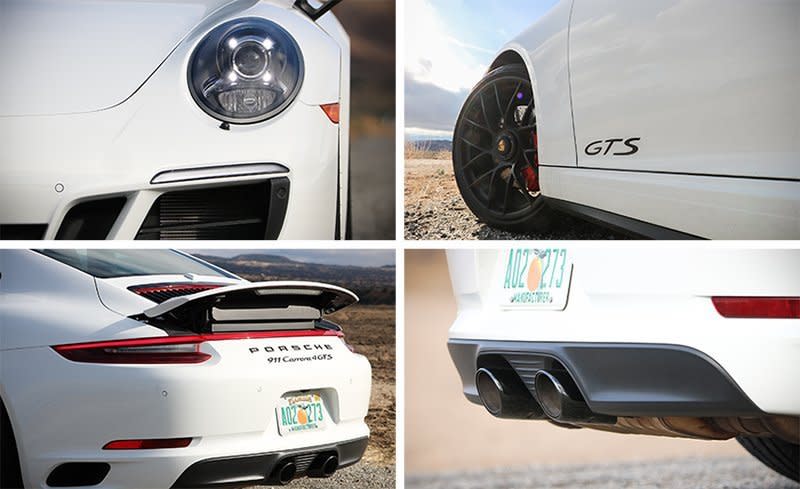
Let the GTS engine cool overnight in a garage and the mere act of starting it in the morning is spine-tingling. Turn the key to the left of the steering column and the engine-control computer makes a quick assessment of the situation before the flat-six rips to life with a thrilling chord of anticipation. The louder, more dramatic Sport Exhaust system that’s optional on other 911s is standard with the GTS. The idle stays high for a few minutes with a growl from the tail outlets that’s so intoxicating the driver will just sit there listening . . . waiting . . . soaking in the six-cylinder aria . . . forgetting what the whole trip was about beyond this sound. The 911 GTS, just sitting there with the shifter in neutral, is more exciting than most cars ever get.
The all-wheel-drive Carrera 4 GTS is easier to launch than the rear-drive version. Whatever torque can’t be used by the monstrously large 305/30R-20 rear tires goes forward to be applied to the road through the 245/35R-20 front rubber. It takes some concentration to make every shift cleanly, but it’s a skill that’s quickly mastered, aided by the high-quality tools that are the clutch and the shifter. And this thing is quick.
Blasting and Blazing
The blitz to 60 mph takes 3.5 seconds while the quarter-mile passes in 11.9 seconds at 120 mph. To put that in historical perspective, in 1987 Car and Driver tested the ridiculously high-tech Porsche 959, the now legendary 444-hp, $227,000 (that’s about $488,000 in 2018 bucks) supercar. It achieved a zero-to-60-mph time of 3.6 seconds and knocked out the quarter-mile in 12.0 flat at 116 mph. So, this new 911 Carrera 4 GTS performs better than a 959 in practically every measurable way. In fact, it’s spooky how closely the 911 Carrera 4 GTS tracks the 959’s performance.
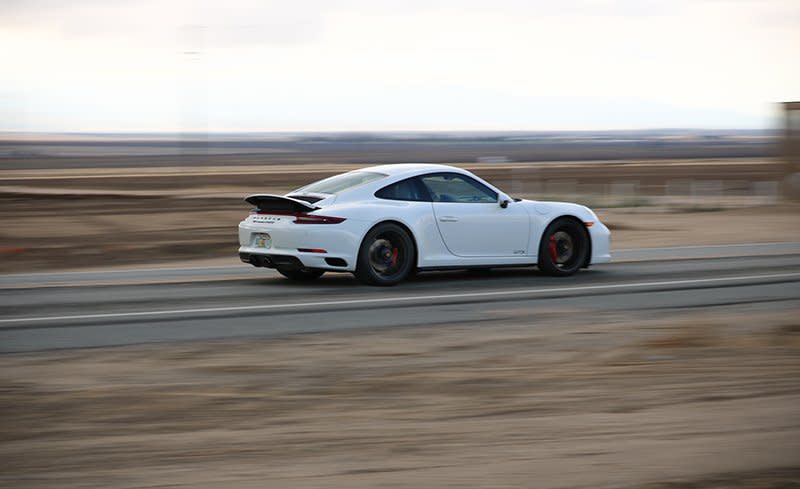
Keeping that in mind, know that this isn’t even the hot setup for the 911 Carrera GTS. That would be the rear-wheel-drive coupe equipped with Porsche’s PDK dual-clutch automatic transmission. In our testing, that car defied logic and several laws of physics once thought immutable to reach 60 mph in 3.0 seconds and destroy the quarter-mile in 11.3 at 125 mph. The combination of Porsche’s launch-control system and the PDK is flat astounding, and we can’t match it shifting for ourselves.
The GTS engine is incredibly flexible, too, making it delightful to deploy its energies the old-fashioned way. The low-end torque talent of the engine means that second gear is practically the only one needed to scoot around town. And when pushed on a track, it’s forgiving of missed shifts and boneheaded throttle applications in ways that the more narrowly focused GT3 or GT2 can’t be.
The 70 Percent Solution
Every GTS gets the flared hips of the Carrera 4 and needs those fat fenders to cover the enormous tires. The GTS also gets the Porsche Active Suspension Management (PASM) system in some form or another—cabriolets and Targas use the milder version while coupes get the Sport spec—with a slightly lower ride height and electronic wizardry to make sure all the differentials involved are on the same page.
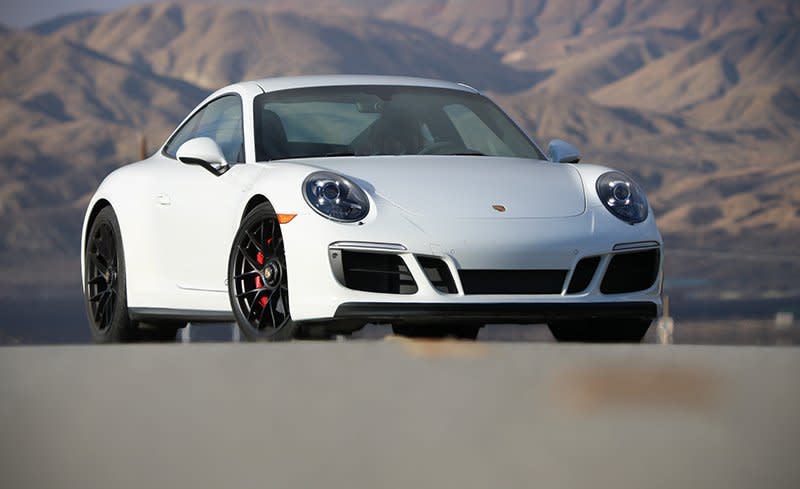
Porsche builds plenty of 911s that are spectacular for tenth-tenths bonkers track duty. What the GTS does best is reward those precious moments when a driver finds an obscure, almost empty, lightly patrolled back road that’s perfectly curvy and beautifully paved. Gripping the wheel at three and nine, the relatively light clutch under the driver’s left big toe, the right foot hovering over the accelerator pedal, the car comes alive. At seven-tenths, the GTS is entertaining like Duke Ellington and His Orchestra. The front tires bite into every corner as if they had never before tasted anything so delicious. The tail follows with the tenacity of a puppy chewing the legs off a Barcalounger, and the conventional disc brakes manage that elusive mix of amazing whoa! without the grab that comes with exotic pad and rotor materials.
This is just the sort of decompression chamber that wipes the edge off a long day performing surgery or harmonizing depositions.
Still, there’s a lot of grip at full chat, too. This 911 Carrera 4 GTS coupe stuck to the skidpad at 1.06 g—enough to have brain matter pouring out of your ears. Stopping from 70 mph in a mere 145 feet was consistently astonishing, and the brakes proved fade free. The lesser 911s might ride a little more smoothly. But swapping out an iota of comfort for a pound of performance strikes us as a good deal.
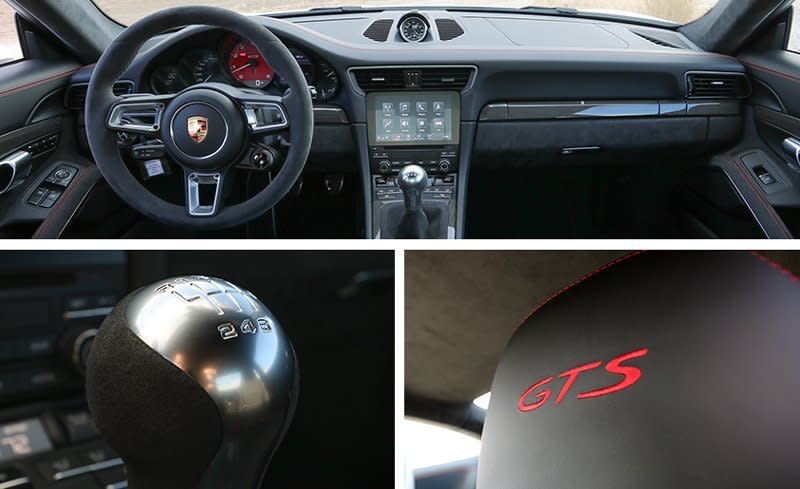
The Belly of the Alcantara Beast
Alcantara is a brand name for a synthetic material we usually call microsuede or some other generic term. It has gathered a mighty reputation for durability and grip beyond mere leather. And the stuff is slathered on practically every surface inside the GTS: seats, door panels, headliner, and steering wheel. If an Alcantara were an animal, the inside of the 911 Carrera GTS would be its stomach. The GTS gets more of this material than any lesser 911 without resorting to Porsche’s deep options list.
Nevertheless, we can find some criticisms about the 911 cockpit: The shifter itself is about a half-inch too tall, while the interlocking circles that define the instrumentation may restrict Porsche’s opportunities to fully exploit modern display screens.
Porsche pays a lot of respect to 911 traditions in this cabin, but at some point, it may be better off dumping some of those shackles. The center screen for managing the navigation and infotainment systems should be allowed to grow larger, some of the controls remain too obscurely marked, and the climate-control system proved frustrating the entire time we had this car. Porsche is rightfully cautious about screwing with traditions here—buyers who fall in love with the 911’s cockpit decades before they have the money to buy one aren’t likely to fall among the early adopters of new technology—but it has come time to push against those boundaries, too.
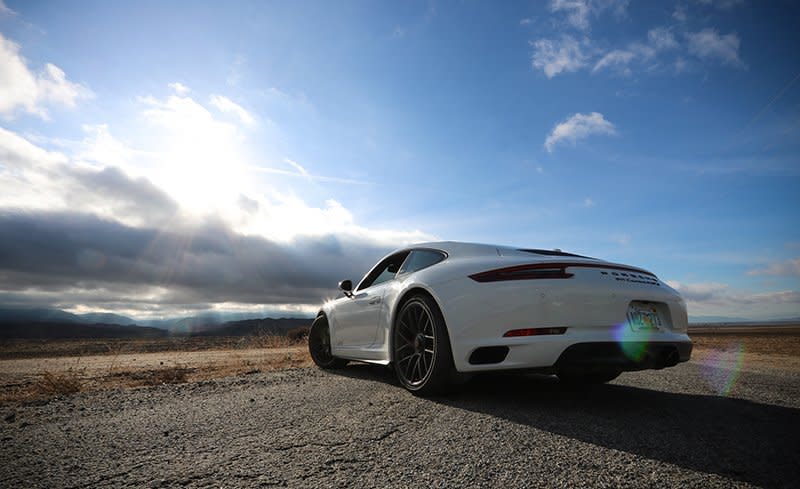
Can’t Spell Greatness without GTS
Porsche sells (or soon will) GTS versions of all its cars and SUVs. Except for a few embellishments like dark surrounds in the headlight buckets, tweaked taillight lenses, and specific bumper covers, the GTS packages are mostly bundled collections of options that enthusiastic drivers would choose anyhow. With the 450-hp engine now a $13,770 option on the Carrera S, the company is further blurring the distinctions.
What the GTS reminds us, though, is that the best thing about the 911 is how it can be used as a regular car. Even though it now performs like a 959, it still gets up most driveways without scraping its nose, still has room for a couple bags of groceries in its front trunk, and is still comfortable enough that commutes are a joy. There’s an intimacy and practicality to every 911 that hasn’t been duplicated by any other sports car. The Carrera 4 GTS is, best of all, a 911.
Buy one and wear it out.
Specifications >
VEHICLE TYPE: rear-engine, all-wheel-drive, 2+2-seat, 2-door coupe
PRICE AS TESTED: $142,945 (base price: $126,950)
ENGINE TYPE: twin-turbocharged DOHC 24-valve flat-6, aluminum block and heads, direct fuel injection
Displacement: 182 cu in, 2981 cc
Power: 450 hp @ 6500 rpm
Torque: 405 lb-ft @ 2150 rpm
TRANSMISSION: 7-speed manual
DIMENSIONS:
Wheelbase: 96.5 in
Length: 178.3 in
Width: 72.9 in Height: 50.6 in
Passenger volume: 70 cu ft
Cargo volume: 5 cu ft
Curb weight: 3421 lb
C/D TEST RESULTS:
Zero to 60 mph: 3.5 sec
Zero to 100 mph: 8.2 sec
Zero to 130 mph: 13.7 sec
Zero to 150 mph: 20.0 sec
Rolling start, 5–60 mph: 4.8 sec
Top gear, 30–50 mph: 13.9 sec
Top gear, 50–70 mph: 9.4 sec
Standing ¼-mile: 11.9 sec @ 120 mph
Top speed (drag limited, mfr's claim): 193 mph
Braking, 70–0 mph: 145 ft
Roadholding, 300-ft-dia skidpad: 1.06 g
C/D FUEL ECONOMY:
Observed: 21 mpg
EPA FUEL ECONOMY:
Combined/city/highway: 21/18/26 mpg

 Yahoo Autos
Yahoo Autos 